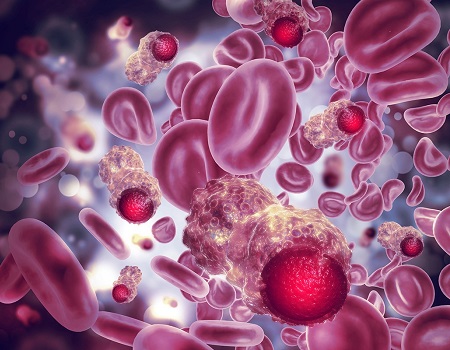CANCER refers to the abnormal and uncontrolled proliferation of tissue in any part of the body. Cancer is not a single disease with a single cause; rather, it is a group of distinct diseases with different causes, manifestations, treatments, and prognoses. It is associated with lifestyle, work place (environmental hazards) excessive exposure to radiations. Cancer has consequences: physical, social, psychological and even financial deterioration. When cancer develops, several patterns of cell growth exist: hyperplasia, metaplasia, dysplasia, anaplasia, and neoplasia which literally means abnormality in the functions of the cells. Cancer can either be malignant or benign. Benign and malignant cells differ in cellular growth characteristics, including the method and rate of growth, ability to metastasize or spread, general effects, destruction of tissue, and ability to cause death. Cancer treatment is a worrisome issue as it entails stressful adherence to drugs regiment. Furthermore, the drugs are high chemicals that have the capacity to destroy the growing abnormal cells: other treatments include surgery or radiation, all of which bring about anxiety and other psychological disturbances.
Cancer is among the leading causes of death worldwide. In 2018, there were 18.1 million new cases and 9.5 million cancer-related deaths worldwide. As of January 2019, there were an estimated 16.9 million cancer survivors in the United States. The number of cancer survivors is projected to increase to 22.2 million by 2030. The cancer mortality rate is higher among men than women (189.5 per 100,000 men and 135.7 per 100,000 women). When comparing groups based on race/ethnicity and sex, cancer mortality is highest in African American men (227.3 per 100,000) and lowest in Asian/Pacific Islander women (85.6 per 100,000). (Iternational Agency for Research on Cancer) As of 2018 in Nigeria, there were 115,950 cases of cancer and fatality cases due to cancer. Research shows that there is substantial increase in the rate of cancer, leading to increase in mortality rate. This drew my attention. Cancer involves abnormal cells growing uncontrollably anywhere in the body. Cancer is a genetic disease—that is, it is caused by changes to genes that control the way our cells function, especially how they grow and divide.
Genetic changes that cause cancer can be inherited from our parents. They can also arise during a person’s lifetime as a result of errors that occur as cells divide or because of damage to DNA caused by certain environmental exposures. Cancer-causing environmental exposures include substances, such as the chemicals in tobacco smoke, bacteria, viruses, dietary and radiation, such as ultraviolet rays from the sun. (National Cancer Institute). Some common causes of cancer are smoking and tobacco, diet and physical activity, sun and other types of radiation and viruses and other infections. (American Cancer Society.)
A tumor is an abnormal mass of cells and generally, Tumors can either be benign (non-cancerous) or malignant (cancerous). Benign tumors grow locally and do not spread. As a result, benign tumors are not considered cancer. They can still be dangerous, especially if they press against vital organs like the brain. Malignant tumors have the ability to spread and invade other tissues. This process, known as metastasis, is a key feature of cancer. There are many different types of malignancy based on where a cancer tumor originates. (Charles Patrick David, 2016.). There are more than 100 types of cancer. Types of cancer are usually named for the organs or tissues where the cancers form. For example, lung cancer starts in cells of the lung, and brain cancer starts in cells of the brain. Cancers also may be described by the type of cell that formed them, such as an epithelial cell or a squamous cell. Carcinoma are the most common type of cancer. They are formed by epithelial cells, which are the cells that cover the inside and outside surfaces of the body. Carcinomas that begin in different epithelial cell types have specific names; Adenocarcinoma is a cancer that forms in epithelial cells that produce fluids or mucus. Tissues with this type of epithelial cell are sometimes called glandular tissues. Most cancers of the breast, colon, and prostate are adenocarcinomas.
Sarcomas are cancers that form in bone and soft tissues, including muscle, fat, blood vessels, lymph vessels, and fibrous tissue (such as tendons and ligaments). Osteosarcoma is the most common cancer of bone. Cancers that begin in the blood-forming tissue of the bone marrow are called leukemias. These cancers do not form solid tumors. Instead, large numbers of abnormal white blood cells (leukemia cells and leukemic blast cells) build up in the blood and bone marrow, crowding out normal blood cells. The low level of normal blood cells can make it harder for the body to get oxygen to its tissues, control bleeding, or fight infections. There are four common types of leukemia; acute lymphoid leukemia, chronic lymphoid leukemia, acute myloid leukemia and chronic myloid leukemia Lymphoma is cancer that begins in lymphocytes (T cells or B cells). These are disease-fighting white blood cells that are part of the immune system. In lymphoma, abnormal lymphocytes build up in lymph nodes and lymph vessels, as well as in other organs of the body. Multiple myeloma is cancer that begins in plasma cells, another type of immune cell. The abnormal plasma cells, called myeloma cells, build up in the bone marrow and form tumors in bones all through the body. Multiple myeloma is also called plasma cell myeloma and Kahler disease. Melanoma is cancer that begins in cells that become melanocytes, which are specialized cells that make melanin (the pigment that gives skin its color).
There are different types of brain and spinal cord tumors. These tumors are named based on the type of cell in which they formed and where the tumor first formed in the central nervous system. For example, an astrocytic tumor begins in star-shaped brain cells called astrocytes, which help keep nerve cellshealthy. Brain tumors can be benign (not cancer) or malignant (cancer). Germ cell tumors are a type of tumor that begins in the cells that give rise to sperm or eggs. These tumors can occur almost anywhere in the body and can be either benign or malignant. Neuroendocrine tumors form from cells that release hormones into the blood in response to a signal from the nervous system. These tumors, which may make higher-than-normal amounts of hormones, can cause many different symptoms. Neuroendocrine tumors may be benign or malignant. (National Cancer Institute). Nurses and physicians have traditionally been involved with tertiary prevention, the care and rehabilitation of the patient after cancer diagnosis and treatment.
A patient undergoing extensive testing is usually fearful of the procedures and anxious about the possible test results. The nurse can help relieve fear and anxiety by explaining the tests to be performed, the sensations likely to be experienced, and the patient’s role in the test procedures. The nurse encourages the patient and family to voice their fears about the test results, supports the patient and family throughout the test period, and reinforces and clarifies information conveyed by the physician. The nurse also Chart 16-2 Risk Factors: Taking Steps to Reduce Cancer Risk When teaching individual patients or groups, nurses can recommend the following cancer prevention strategies:
- Increase consumption of fresh vegetables (especially those of the cabbage family) because studies indicate that roughage and vitamin-rich foods help to prevent certain kinds of cancer. 2. Increase fiber intake because high-fiber diets may reduce the risk for certain cancers (eg, breast, prostate, and colon). 3. Increase intake of vitamin A, which reduces the risk for esophageal, laryngeal, and lung cancers. 4. Increase intake of foods rich in vitamin C, such as citrus fruits and broccoli, which are thought to protect against stomach and esophageal cancers. 5. Practice weight control because obesity is linked to cancers of the uterus, gallbladder, breast, and colon. 6. Reduce intake of dietary fat because a high-fat diet increases the risk for breast, colon, and prostate cancers. 7. Practice moderation in consumption of salt-cured, smoked, and nitrate-cured foods; these have been linked to esophageal and gastric cancers. 8. Stop smoking cigarettes and cigars, which are carcinogens. 9. Reduce alcohol intake because drinking large amounts of alcohol increases the risk of liver cancer. (Note: People who drink heavily and smoke are at greater risk for cancers of the mouth, throat, larynx, and esophagus.) 10. Avoid overexposure to the sun, wear protective clothing, and use a sunscreen to prevent skin damage from ultraviolet rays that increase the risk of skin cancer. Adapted from the “Taking Control” program of the American Cancer Society. encourages the patient and family members to communicate and share their concerns and to discuss their questions and concerns with each other.
MANAGEMENT OF CANCER
Treatment options offered to cancer patients should be based on realistic and achievable goals for each specific type of cancer. The range of possible treatment goals may include complete eradication of malignant disease (cure), prolonged survival and containment of cancer cell growth (control), or relief of symptoms associated with the disease (palliation).
Multiple modalities are commonly used in cancer treatment. A variety of therapies, including surgery, radiation therapy, chemotherapy, and biologic response modifier (BRM) therapy, may be used at various times throughout treatment.
The most common modalities in the treatment of cancer are;
- Surgery
- Radiation Therapy
- Chemotherapy
SURGERY: is the complete or incomplete surgical removal of the cancer cells.
Surgical removal of the entire cancer remains the ideal and most frequently used treatment method.
Surgery may be the primary method of treatment, or it may be prophylactic, palliative, or reconstructive. (International Radiosurgery Support Association, 2000)
RADIATION THERAPY
In radiation therapy, ionizing radiation is used to interrupt cellular growth. More than half of patients with cancer receive a form of radiation therapy at some point during treatment. Radiation may be used to cure the cancer, as in Hodgkin’s disease, testicular seminomas, thyroid carcinomas, localized cancers of the head and neck, and cancers of the uterine cervix. Radiation therapy may also be used to control malignant disease when a tumor cannot be removed surgically or when local nodal metastasis is present, or it can be used prophylactically to prevent leukemic infiltration to the brain or spinal cord. (International Radiosurgery Support Association, 2000)
CHEMOTHERAPY
In chemotherapy, antineoplastic agents are used in an attempt to destroy tumor cells by interfering with cellular functions and reproduction.
Chemotherapy is used primarily to treat systemic disease rather than lesions that are localized and amenable to surgery or radiation. Chemotherapy may be combined with surgery or radiation therapy, or both, to reduce tumor size preoperatively, to destroy any remaining tumor cells postoperatively, or to treat some forms of leukemia.
Example of antineoplastic agents are;
- Alkylating Agents: busulfan, carboplatin, chlorambucil, cisplatin, cyclophosphamide, dacarbazine, hexamethyl melamine, ifosfamide, melphalan, nitrogen mustard, thiotepa
- Antimetabolites: 5-azacytadine, cytarabine, edatrexate fludarabine, 5-fluorouracil (5-FU), FUDR, gemcitabine, hydroxyurea, leustatin, 6-mercaptopurine, methotrexate, pentostatin, 6-thioguanine. etc
SOCIOLOGICAL AND EMOTIONAL EFFECTS OF CANCER
Victims of cancer undergoes series of sociological and emotional deterioration as a result of certain changes that happens when cancer is developed or treated, in the course of treatment there may be possibility of losing a limb, breast, uterus or any other important part of the body, as a result the victims will feel so intimidated while social interacting.
I make in details some social and emotional effect of cancer;
- Body image and self-esteem: victims may be adjusting to scars, weight changes, the loss of a breast or other body part, or other changes to your body. Some parts of the body might not work the way they used to. This can leave a feeling of self-conscious about going out or about being intimate with a partner.
- Depression: Depression affects about two in 10 people with cancer, according to the National Cancer Institute. depression may be as a result of phantom limb, phantom breast, etc.
- Fear that cancer will return: Cancer victims always develope excessive fear that cancer may return even after it’s successfully treated.
- Grief: It’s common, even expected, to feel a sense of loss of old life. Yet many patients are surprised by the intensity of emotions surrounding the need to adjust to a new normal.
- Relationships: Cancer can strain relationships with friends, family and co-workers. People might treat you differently or not know what to say. People you expected to stand by you may have backed away, and people you didn’t count on may have become closer.
- Stress: The changes that come with cancer, treatment and survivorship can increase anxiety. victims may face the return of problems that they set aside during treatment.
- Work: After cancer, re-entering social and professional life can be challenging. Many fear an increased risk of infection, lack of energy, and anxiety about work performance. At the same time, work can bring a sense of normalcy. OHSU Knight Cancer Institute 2015.
- Spirituality: Many survivors find that life takes on new meaning after cancer and will renew their commitment to spiritual practices or organized religion. Research suggests that spirituality improves quality of life through a strong social support network, adaptive coping, lessened depression and better physiological function. MD Anderson Center 2020.
Cancer is the abnormal and uncontrolled proliferation of tissue in any part of the body, due to the changes that occur during cancer development or treatment, so many sociological and emotional changes developed such as stress, guilt, anxiety, self isolation.
Cancer is also one of the leading factor of death in developed countries. In 2018, there were 18.1 million new cases and 9.5 million cancer-related deaths worldwide.
Shuni, a nurse, writes in from Sokoto State via Salihushuni@gmail.com
YOU SHOULD NOT MISS THESE HEADLINES FROM NIGERIAN TRIBUNE
Rays of the afternoon sun pelted her head as she fanned the embers beneath the half-cut iron drum with the smoke permeating the air. “This smoke is unbearable, Iya Maria,” said one of the three neighbours conversing under a makeshift shed about five meters away. Their voices rose and fell intermittently…
Selfies, video calls and Chinese documentaries: The things you’ll meet onboard Lagos-Ibadan train
The Lagos-Ibadan railway was inaugurated recently for a full paid operation by the Nigerian Railway Corporation after about a year of free test-run. JUSTICE NWAFOR joined the train to and fro Lagos from Ibadan and tells his experience in this report…






